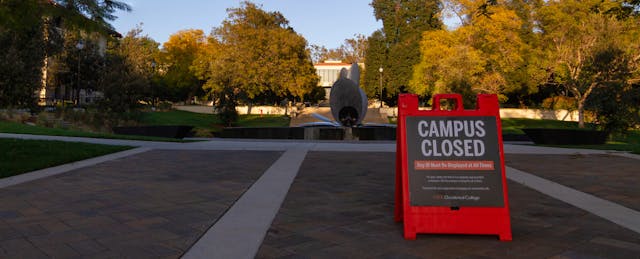At the start of what would soon be known around the world as the COVID-19 pandemic, leaders in the higher education industry began to fear the worst. Within days, colleges and universities around the nation announced their respective continuity-of-service plans to provide instruction and student support remotely. Using an array of digital communication technologies, messaging platforms and learning management systems, institutions were able to continue operations and maintain their student market share.
Honoring the work of several institutions that successfully pivoted to the online space, in fall 2020, NASPA contacted researchers, edtech experts and higher education professionals, including myself, to advise them on what became the Virtual Innovation Awards: Excellence in Delivering Virtual Student Services. From more than 100 submissions by colleges and universities, NASPA’s team of advisers selected 10 institutions to award using the following eight categories: Connection Building, Holistic Approach, Ingenuity, Equity Focus, Scalability and Sustainability, Strategic Technology Use, Collaboration, and Data Use.
However, the reality is that not every institution of higher learning was fortunate enough to showcase such flexibility. Some started to fold under pandemic conditions. And while those of us who work at institutions that have held on so far may be tempted to breathe a sigh of relief, that would be a mistake. As I’ll explain, not even award-winning colleges are necessarily safe from the challenges still facing higher education.
After years of financial struggles, MacMurray College in Illinois announced its closure early on, followed by Becker College in Massachusetts and Mills College in California. However, Mills has since merged with Northeastern University. Such closures, mergers and other shifts to try to reach sustainability are reflected in National Center for Educational Statistics reports. Since the 2018-2019 school year, the number of institutions eligible to award federal financial aid fell from 6,281 to 6,063, or 3.47 percent. For the public two-year college sector, the number of institutions fell from 963 to 920, or 4.46 percent. However, it is important to note that NCES data as presented does not fully account for the number of two-year institutions reclassified due to offering baccalaureate programs.
Despite this unfortunate reality, financial experts predicted that many more institutions were slated to close or merge than ended up doing so. The derailment of such misfortune is largely due to the urgent action by legislators to save U.S. colleges and universities.
The CARES Act that Congress signed into law in March 2020 earmarked $2.2 trillion to aid Americans negatively impacted by the pandemic. Of those funds, approximately $14 billion was designated as the Higher Education Emergency Relief Fund, or HEERF. Then, in January 2021, the U.S. Department of Education announced an additional tranche of $21.2 billion to higher education. Most recently, in March, the Higher Education Emergency Relief Fund III, known as the American Rescue Plan, was signed into law, providing $39.6 billion in support to institutions of higher education to serve students and ensure learning continues during the pandemic. In total, since March 2020, higher education has received $74.8 billion dollars to remain operational and serve students, while also providing emergency aid to students impacted by COVID-19.
Across the nation, colleges were granted a financial reprieve for what may have otherwise been a death sentence, preventing what could have been an insurmountable increase in institutional closures and mergers. Terms like “innovation” and “resiliency” were used to describe the actions of many institutions using HEERF, while terms like “disruption” were used to describe the times. While I do believe that COVID-19 is an unprecedented disruptor and accelerator in higher education, I also believe an important question still remains unanswered. Has higher education truly innovated and transformed to meet the essential needs and expectations of its students? Or, did higher education simply find an “innovative” and “resilient” means of maintaining business as usual?
Moments before the pandemic took hold, national conversation was taking place regarding the diminishing public trust in higher education and ways to address it. Undoubtedly, HEERF funds removed barriers for students to continue their studies and promoted equitable student success to those impacted heavily by COVID-19. However, in some conversations I’ve had with fellow college presidents around the country, I have heard expressed the belief that HEERF has aided the restoration of public trust in higher education—an idea I wholeheartedly consider to be false. Public mistrust at best has been pacified by how colleges have used HEERF funds, and confidence in higher ed is far from being restored.
Based on recent guidelines from the Department of Education, institutions of higher education generally must expend their HEERF grants within one year of the date when the department processed funds for each specific grant. That means for many institutions, HEERF funds will cease to be accessible in the year 2022. How will institutions serve students once the additional support ends? How will institutions find means to deliver student support and instruction on par with student expectations? How will institutions work creatively with industry to develop new pathways to employment or find breakthrough means of promoting social and economic mobility? All toward the aim of breaking down social barriers that have prohibited the success of our diverse students and their communities.
Equitable student success demands that institutions embrace new ideology and methodology for how they serve students. Our communities demand that institutions stop using slogans and marketing campaigns to mask the unaddressed gaps in processes and services provided. The times demand that institutions stop being initiative-driven and start being mission-driven. Essentially, that means making an integrous commitment, through strategic planning and mission alignment, to ensure long-term, continuous improvement of student supports that are intentionally integrated into the fabric of the institution. The future of higher education, and the restoration of public trust in it, depends on colleges and universities embracing the wholeness of being student-centered institutions and dismantling college business as usual.


